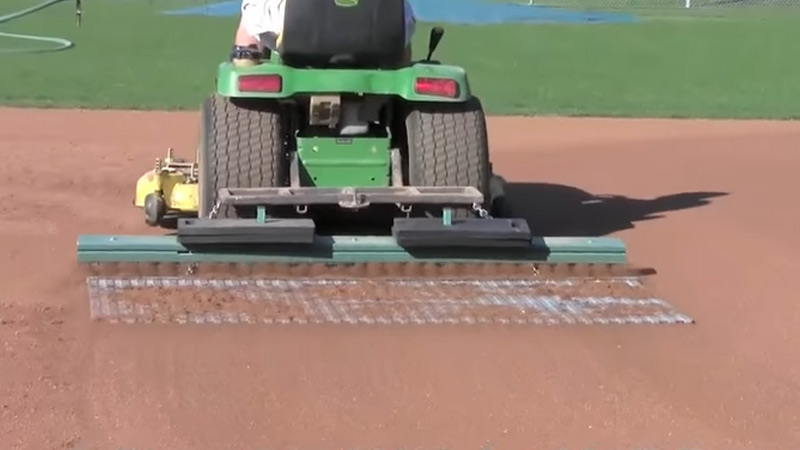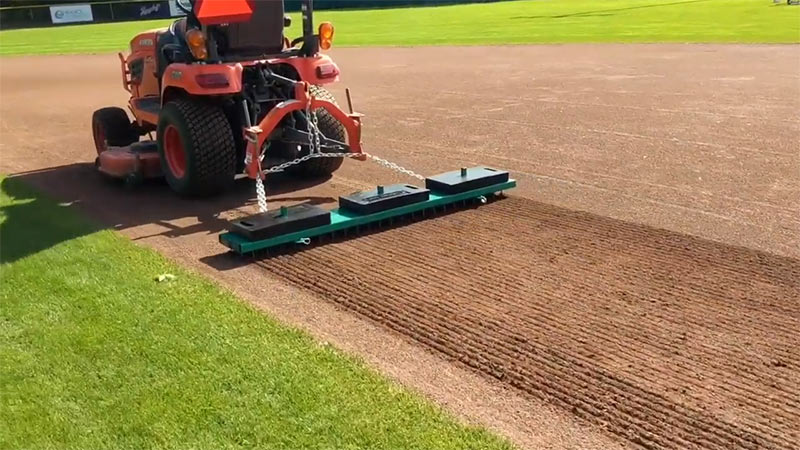Maintaining a well-groomed baseball field is crucial for providing optimal playing conditions and ensuring the safety of players. One important aspect of field maintenance is nail dragging, which involves dragging nails or spikes across the field’s surface to achieve a desired level of smoothness.
In this comprehensive guide, we will explore the process of nail-dragging a baseball field, including its purpose, different types of drag techniques, and step-by-step instructions to effectively perform this task.
What Is Nail Dragging?
Nail dragging is a field maintenance technique that plays a crucial role in achieving a well-groomed baseball field. It involves the process of dragging nails or spikes across the surface of the field, typically the infield dirt.
The main purpose of nail dragging is to level out the playing surface, remove excess moisture, and enhance the overall quality of the field for optimal gameplay.
The process of nail dragging creates small grooves or indentations in the infield dirt, which serves several important functions. Firstly, it helps to improve traction for players, allowing them to run, field, and slide more smoothly.
These grooves provide grip and stability, reducing the risk of slips and fall, particularly in damp or wet conditions.
Another important function of nail dragging is moisture control. When it rains or when the field is irrigated, water can accumulate on the surface, resulting in muddy or waterlogged areas.
Nail dragging helps to remove excess water by creating channels or furrows in the dirt, allowing it to drain more efficiently. This aids in faster drying of the field, reducing the downtime after rain and ensuring games can resume sooner.
Moreover, nail dragging also assists in preventing water pooling and the formation of puddles. When water accumulates in certain areas, it can cause uneven playing conditions and affect ball bounce and roll.
The grooves created by nail dragging help to redirect water flow, preventing it from settling in one spot and promoting even distribution across the field.
Furthermore, nail dragging contributes to the overall aesthetic appeal of the field. A well-dragged field with neat and consistent grooves presents a professional and visually pleasing appearance.
It showcases the dedication to field maintenance and creates a positive impression for players, coaches, and spectators.
Why It Is Essential to Nail Drag a Baseball Field?

Here are the essential reasons why people nail-drag a baseball field.
Field Renovation
Regular nail dragging is an essential part of field renovation. Over time, constant usage and foot traffic can cause the infield dirt to become compacted and uneven.
Nail dragging helps break up the compacted soil, remove debris such as rocks and twigs, and level the playing surface. It also helps to ensure proper drainage, preventing water from accumulating and creating muddy areas on the field.
Following a Rain Event
After a rain event, nail dragging becomes even more important. Waterlogged fields can cause delays in game schedules and create hazardous playing conditions.
Nail dragging helps to remove excess water, allowing the field to dry faster and reducing the risk of injuries due to slippery surfaces. It also helps to prevent the formation of puddles, which can disrupt gameplay and affect ball movement.
Game Day Nail Dragging
Nail dragging just before a game ensures a smooth and well-groomed playing surface. Warm-up activities and previous games can cause footprints, divots, and other irregularities on the field.
Nail dragging helps to erase these marks and create a consistent surface for players. It also helps improve player safety by reducing the risk of tripping or stumbling on uneven areas.
Types of Drag in Baseball
There are several types of drag techniques used in baseball field maintenance:
Nail Drag
The most common type of drag in baseball field maintenance involves attaching nails or spikes to a drag mat and pulling it across the field.
The nails or spikes create small indentations or grooves in the infield dirt, which helps to level the surface, break up compacted soil, and improve drainage. The size and type of nails used may vary depending on the field conditions and personal preference.
Bolt Drag
A bolt drag utilizes a chain-link fence section or a metal drag mat with bolts or nails attached. This type of drag is particularly useful for breaking up compacted soil and removing debris.
The bolts or nails protruding from the drag mat penetrate the infield dirt, loosening it and promoting better aeration. Bolt dragging can be an effective method for maintaining the overall health of the field.
Screen Drag
A screen drag involves using a mesh or fabric screen instead of nails or spikes. This type of drag is designed to smooth out the infield dirt and remove small rocks or particles that may affect gameplay.
The screen drags across the field, breaking up clumps of dirt and leveling the surface. It is especially useful for fields with heavy clay or loamy soil compositions.
Finish Drag
A finish drag is performed after other types of dragging to give the field a polished appearance. It involves dragging a mat or broom with no nails or spikes to lightly groom the surface.
Finish dragging helps to smooth out any remaining imperfections, such as small ridges or uneven areas, resulting in a visually appealing and player-friendly playing surface.
How to Nail Drag a Baseball Field?

To nail-drag a baseball field effectively, follow these step-by-step instructions:
Use 40 Penny Nails
When selecting nails for nail dragging, it is recommended to use 40-penny nails. These nails are typically 8-10 inches long and are specifically designed for field maintenance purposes.
The length of these nails allows them to penetrate the infield dirt effectively and create the desired grooves without being too shallow or too deep. The durability of 40 penny nails ensures they can withstand the dragging process and last longer.
Drill Some Straight Holes for Nails
To ensure the nails go in straight and minimize the risk of them bending or breaking during the dragging process, it is advisable to pre-drill small holes along the length of a 2″ x 4″ board.
The holes should be drilled at regular intervals and should be slightly narrower than the diameter of the nails. Pre-drilling the holes helps guide the nails and ensures they enter the infield dirt smoothly.
Use 1″ x 4″ to Cover 2″ x 4″ on Top for Holding in Nails
To prevent the nails from falling out or shifting positions during the dragging process, it is recommended to place a 1″ x 4″ board on top of the pre-drilled 2″ x 4″ board. This additional board acts as a cover and helps hold the nails in place securely.
The 1″ x 4″ board should be aligned with the pre-drilled holes, allowing the nails to pass through the board while keeping them firmly in position.
Stagger Nails 1″ Apart and Have 2 Rows
To achieve optimal coverage and create consistent grooves across the entire infield dirt, it is important to stagger the nails appropriately. Insert the nails into the pre-drilled holes, staggering them approximately 1″ apart from each other.
This spacing ensures that the nails create an even distribution of grooves and prevent any gaps or overlapping. Additionally, having two rows of nails in each board allows for maximum efficiency during the dragging process, as it covers a wider area with each pass.
Drag the Field
Once the nail drag apparatus is prepared, it is time to drag the field. Attach the nail drag apparatus to a drag mat or connect it to a vehicle or tractor, depending on the equipment available to you.
Starting at one end of the field, slowly and evenly drag the nails across the infield dirt, covering the entire surface. It is recommended to make multiple passes to ensure thorough coverage and to ensure the nails penetrate the soil adequately.
Pay special attention to high-traffic areas such as the pitcher’s mound, home plate, and bases, as these areas may require additional dragging to maintain a consistent playing surface.
By following these detailed steps, you can effectively nail drag a baseball field, promoting optimal playing conditions, improving drainage, and enhancing the safety and enjoyment of the game.
Remember to adjust the frequency of nail dragging based on factors such as weather conditions, field usage, and the specific needs of your field to ensure its long-term maintenance and longevity.
How Often Should I Nail-drag A Baseball Field?
The frequency of nail dragging depends on various factors such as field usage, weather conditions, and personal preferences. Typically, it is recommended to perform nail dragging at least once a week during the playing season.
However, if the field experiences heavy usage or after significant rainfall, more frequent nail dragging may be necessary to maintain optimal playing conditions.
It is important to note that while nail dragging is beneficial for natural grass fields, it is not suitable for synthetic turf fields. Synthetic turf fields have their specific maintenance requirements outlined by the manufacturer, and nail dragging can potentially damage the turf fibers.
If you have a synthetic turf field, it is crucial to follow the recommended maintenance practices provided by the manufacturer.
Nail dragging is a fundamental technique in baseball field maintenance. It serves to level the playing surface, remove excess moisture, improve traction, and enhance the overall quality of the field.
By creating grooves in the infield dirt, nail dragging ensures better drainage, prevents water pooling, and contributes to a visually appealing field. Regular nail dragging, along with other field maintenance practices, is key to providing safe and optimal playing conditions for baseball players.
FAQs
Can I use different types of nails for nail dragging?
Yes, you can experiment with different types of nails to find what works best for your field. However, 40-penny nails are commonly used due to their length and durability.
Is nail dragging suitable for synthetic turf fields?
No, nail dragging is not suitable for synthetic turf fields as it can damage the turf fibers. Synthetic fields have their specific maintenance requirements outlined by the manufacturer.
Can I rent equipment for nail dragging?
Yes, many equipment rental companies offer drag mats and tractor attachments specifically designed for field maintenance. Renting can be a cost-effective option if you don’t have access to your own equipment.
Are there any safety precautions to consider during nail dragging?
Yes, always wear appropriate personal protective equipment, such as gloves and safety glasses, when performing nail dragging. Inspect the field for any foreign objects or hazards before dragging to avoid potential injuries.
Bottom Line
Nail dragging is a fundamental aspect of baseball field maintenance, ensuring a level playing surface, proper drainage, and an enhanced playing experience. By following the outlined steps and utilizing the appropriate techniques, you can effectively nail-drag your baseball field, promoting player safety and optimal gameplay conditions.
Regular maintenance, including nail dragging, is essential for keeping the field in top shape and extending its lifespan. Remember to adjust the frequency of nail dragging based on weather conditions, field usage, and the specific needs of your field.
With consistent and proper maintenance, you can enjoy a well-groomed baseball field that provides an enjoyable and safe environment for players and spectators alike. Thank you for your time.







